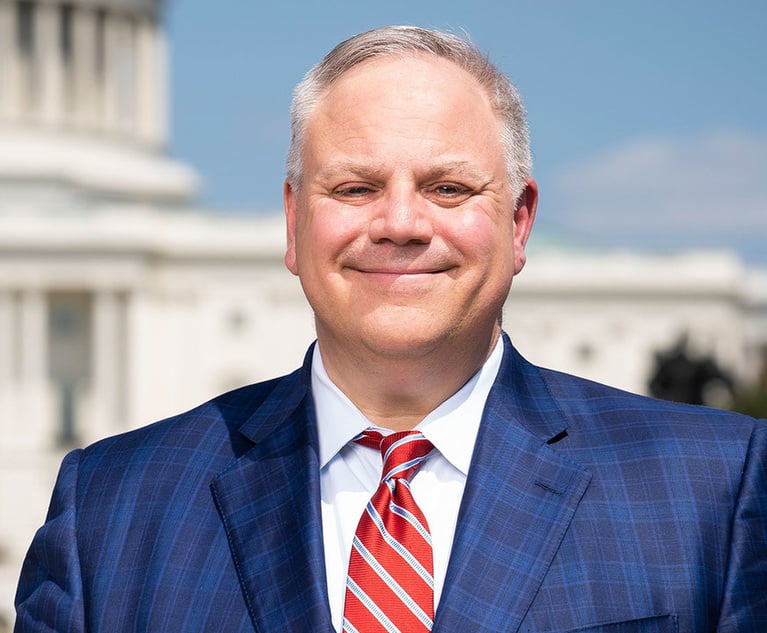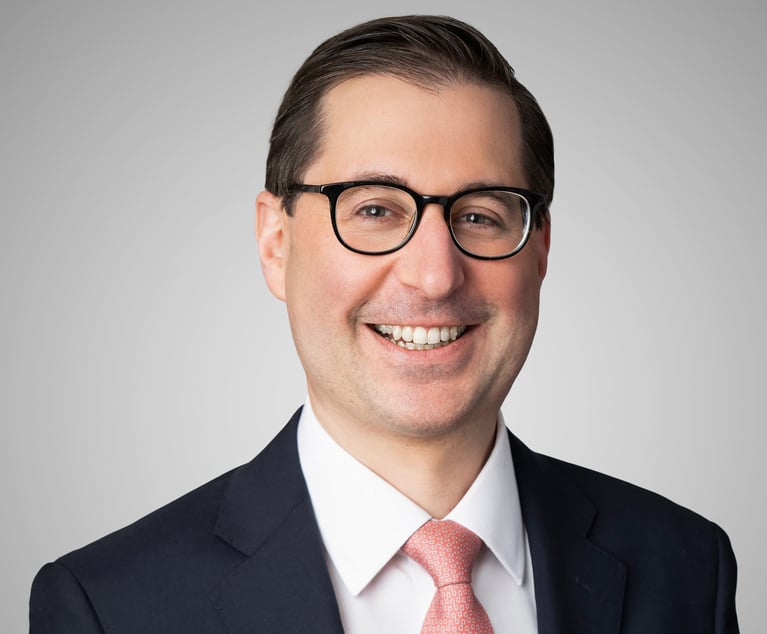Beyond the First Step: Big Law Partners and Former Federal Judges Discuss the Importance of Expansive Criminal Justice Reform
The FIRST STEP Act is aptly named for the series of changes advocates say need to be made for comprehensive criminal justice reform.
December 26, 2018 at 03:20 PM
10 minute read

Of all the times that mandatory minimum sentencing laws forced Kevin Sharp, a retired federal judge who presided in the Middle District of Tennessee, to mete out a punishment that he felt was too harsh, he thinks often of Chris Young, whom Sharp sentenced to life in prison.
Young was twice convicted, at ages 18 and 19, in state court on drug charges, the second time for possessing an amount of cocaine weighing about as much as a quarter—as in a 25-cent piece—Sharp said in an interview.
But in 2010, when Young was 22 years old, he was spotted at a gas station talking to a member of a drug conspiracy—the police said he was making arrangements to buy crack cocaine—and was convicted on federal charges.
"If I had been able to use my discretion, this is a seven-, eight-year sentence, tops," Sharp said of the case.
But the latest offense was strike three for Young, and, in 2014, Sharp had no choice but to send the then-22 year old to prison for the rest of his life.
"It could not have been more unjust," said Sharp who, since stepping down from the bench in 2017, has been an outspoken advocate for sentencing reform.
Sharp, who is now a name partner at Sanford Heisler Sharp in Nashville, is not alone in his criticism: He is among the many former federal judges and prosecutors who have previously wielded the threat of harsh mandatory sentences to lock down guilty pleas and coax cooperators, and who are now calling on Congress to make changes.
John Gleeson, a partner at Debevoise & Plimpton and a retired federal judge from the Eastern District of New York is another. He made his opinions on mandatory minimums known even while still on the bench.
In 2010, for example, Gleeson sparred with the U.S. attorney's office in Brooklyn over the fate of convicted drug dealer Roberto Vasquez, a small-timer in a cocaine-dealing operation who faced a mandatory five-year sentence that Gleeson described as "unjust" in a memo explaining his reasoning for Vasquez's sentence.
Gleeson, himself a former hard-charging Eastern District prosecutor who took down mobster John Gotti, asked the government to drop a factor from Vasquez's conspiracy charge that triggers the five-year minimum: The prosecutor on the case, Assistant U.S. Attorney Bonnie Klapper, said she would take it up with her bosses.
A few months later, Klapper, under the eye of a supervisor who was shadowing her, appeared before Gleeson and reported that her office wasn't backing down its position on the five-year minimum for the defendant.
Klapper explained that Vasquez had already received a "bump down" by pleading guilty to a lesser charge, according to court papers—his original charge carried a 10-year minimum.
"I suppose there is some consolation in the fact that the government did not pursue that absurd course, which would have produced an even more egregious injustice if Vasquez had been convicted," Gleeson wrote, referring to the prior threat of 10 years in prison for Vasquez. "But that hardly explains, let alone justifies, the government's insistence on the injustice at hand."
The government also argued that the judge had failed to focus on the "seriousness" of Vasquez's prior offenses: After splitting up with his ex-wife, who Vasquez said refused to let him see his children, he threatened her with a knife in front of the children. That confrontation led to criminal charges.
Later, Vasquez violated an order of protection by threatening to kill his ex-wife. But Gleeson explained that, despite Vasquez's charges in the drug case, the defendant was trying to get himself on the right track. He got into a stable romantic relationship with someone new, with whom he had daughter and ultimately got engaged. And he kept a steady job as an auto mechanic.
But Vasquez—stressed over paying child support for the children he wasn't able to see—eventually relapsed into cocaine addiction and, to support his expensive habit, took up work selling drugs for his big brother.
"The mandatory minimum sentence in this case supplanted any effort to do justice, leaving in its place the heavy wooden club that was explicitly meant only for mid-level managers of drug operations," Gleeson said.
On Capitol Hill, reforming mandatory minimums is one of the rare issue areas that enjoys wide support in both parties and in both chambers of Congress, though not everyone is in lockstep on how much things should change.
In December, President Donald Trump signed the FIRST STEP Act into law. The law will reduce, but not eliminate, mandatory minimums to allow for more judicial discretion, as well as expand the so-called "safety valve" available for nonviolent defendants with little to no criminal history who cooperate with the government and who face mandatory minimum sentences.
The legislation also retroactively enforces the Fair Sentencing Act of 2010, which leveled out the 100-to-1 disparity in sentencing crimes related to crack-cocaine compared with powder cocaine—a mismatch that tended to favor white defendants over minorities.
The bill has a mixed reaction from law enforcement that includes support from the Fraternal Order of Police but opposition from other groups.
Despite a broad base of support for extensive changes, there's good reason to believe that mandatory minimums may remain in place. While this legislation would impact sentences on the federal level, some 90 percent of prisoners are housed in state and local jails, according to statistics by the U.S. Department of Justice. Not only that, but Washington has its share of tough-on-crime stalwarts in all three branches of federal government:
Among them was Jeff Sessions, who recently resigned as U.S. attorney general at President Trump's request. During his tenure, he ordered federal prosecutors to push for maximum penalties, reversing a policy set by former Attorney General Eric Holder, who served under President Barack Obama, for prosecutors to decline charging the quantity necessary to trigger mandatory minimums for nonviolent offenders who worked as low-level drug dealers.
Holder, now a partner at Covington & Burling in Washington, D.C. has called the move "dumb on crime." Holder served as a D.C. Superior Court judge from 1988 to 1993, a time when he said he began a "slow evolution" in his thinking about how the criminal justice system deals with drug offenders, then served four years as the U.S. attorney for D.C. until joining the Justice Department in 1997.
Alan Vinegrad, Holder's colleague at Covington and a former interim U.S. attorney for the Eastern District of New York who served in that role from 2001 to 2002, has also joined the chorus of voices who say that the federal government needs to rethink mandatory minimums.
"The prevailing wisdom is that more needs to be done," Vinegrad said.
In addition to several Republican members of Congress, vocal opponents to changing the status quo include the National Association of Assistant United States Attorneys, which according to its website has a membership of 1,500 current and former federal prosecutors.
The group is staunchly opposed to ditching mandatory minimums; Lawrence Leiser, president of the group and adjunct faculty at George Mason University, said that mandatory minimums give prosecutors a powerful tool to fight crime. And, with prosecutors across the country fighting on the front lines of America's latest drug scourge, opioids and fentanyl, now is not the time to take it away.
"I think their heart is in the right place," Leiser said of lawmakers. "We would like these defendants to not go back and re-victimize."
Low-Hanging Fruit
Both mandatory minimums and their much-scrutinized cousin, sentencing guidelines, were enacted in the crack cocaine-fueled crime wave of the mid-1980s.
A catalyzing event that led to mandatory minimums was the overdose death of University of Maryland basketball standout Len Bias just days after the 1986 NBA draft.
U.S. Sen. Robert Byrd, a West Virginia Democrat, said at the time that mandatory minimums were intended to decapitate drug rings by bringing strict sentences to kingpins—the "masterminds who really run these operations," as Byrd put it—and middle managers.
But Congress made a mistake, Gleeson said in his 2010 ruling in the Vasquez case, by tying sentences for drug dealers based on the amount of weight their operations move, not how much heft the accused had in their respective organizations.
Thus, sentences can fall heavily on street-level dealers, the "low-hanging fruit for law enforcement," Gleeson said.
In the decades since mandatory minimums were enacted, crime rates have fallen across the country, but the ranks of the incarcerated grew substantially. The U.S. Bureau of Prisons reported a head count of more than 40,300 inmates in federal facilities in its 1985 fiscal year, a number that grew to a high point of almost 219,300 in fiscal 2013. The same is true of state and local prisons and jails. Some states, however, have since successfully reduced their prison populations through reform while simultaneously experiencing lower crime rates.
The previous requirement that judges use the sentencing guidelines was challenged on the grounds of the Sixth Amendment, which provides the right to a jury trial, In 2005, the Supreme Court ruled that judges are not mandated to give sentences determined by the sentencing guidelines and can use them on an advisory basis,
But mandatory minimums remain and, unlike sentencing guidelines, there are no clear paths of attack in terms of bringing a constitutional challenge to effect change, said Sean Hecker, a name partner and white-collar defense attorney at Kaplan Hecker & Fink who serves as chair of the New York City Bar Association's Task Force on Mass Incarceration.
"It's ultimately an effort in trying to persuade state legislatures and Congress that mandatory minimums are wildly ineffective in achieving the aims of a criminal justice system," Hecker said.
Today, about 55 percent of the more than 183,400 inmates in federal prisons were convicted of an offense that carried a mandatory minimum, according to testimony that the National Association of Criminal Defense Lawyers submitted to the U.S. Sentencing Commission in August. Additionally, mandatory sentences have a disproportionate effect on minorities: Almost 63 percent of African-American inmates in the federal system were convicted of an offense with a mandatory minimum sentence, the group testified.
Generally speaking, body politic has in recent years begun to view tough-on-crime policies less favorably. But, despite shifting public attitudes, Gleeson said that much of the reason meaningful criminal justice reform has been hard to achieve on the federal level is that many politicians still fear being seen as too soft on crime.
"We just can't seem to get there, and it's not because there's a really strong, well-thought-out opposition," Gleeson said. "It's just kind of ingrained in us."
This content has been archived. It is available through our partners, LexisNexis® and Bloomberg Law.
To view this content, please continue to their sites.
Not a Lexis Subscriber?
Subscribe Now
Not a Bloomberg Law Subscriber?
Subscribe Now
NOT FOR REPRINT
© 2025 ALM Global, LLC, All Rights Reserved. Request academic re-use from www.copyright.com. All other uses, submit a request to [email protected]. For more information visit Asset & Logo Licensing.
You Might Like
View All
Brownstein Adds Former Interior Secretary, Offering 'Strategic Counsel' During New Trump Term
2 minute read
Weil, Loading Up on More Regulatory Talent, Adds SEC Asset Management Co-Chief
3 minute read
FTC Sues PepsiCo for Alleged Price Break to Big-Box Retailer, Incurs Holyoak's Wrath
5 minute read
Supreme Court Will Hear Religious Parents' Bid to Opt Out of LGBTQ-Themed School Books
Trending Stories
Who Got The Work
J. Brugh Lower of Gibbons has entered an appearance for industrial equipment supplier Devco Corporation in a pending trademark infringement lawsuit. The suit, accusing the defendant of selling knock-off Graco products, was filed Dec. 18 in New Jersey District Court by Rivkin Radler on behalf of Graco Inc. and Graco Minnesota. The case, assigned to U.S. District Judge Zahid N. Quraishi, is 3:24-cv-11294, Graco Inc. et al v. Devco Corporation.
Who Got The Work
Rebecca Maller-Stein and Kent A. Yalowitz of Arnold & Porter Kaye Scholer have entered their appearances for Hanaco Venture Capital and its executives, Lior Prosor and David Frankel, in a pending securities lawsuit. The action, filed on Dec. 24 in New York Southern District Court by Zell, Aron & Co. on behalf of Goldeneye Advisors, accuses the defendants of negligently and fraudulently managing the plaintiff's $1 million investment. The case, assigned to U.S. District Judge Vernon S. Broderick, is 1:24-cv-09918, Goldeneye Advisors, LLC v. Hanaco Venture Capital, Ltd. et al.
Who Got The Work
Attorneys from A&O Shearman has stepped in as defense counsel for Toronto-Dominion Bank and other defendants in a pending securities class action. The suit, filed Dec. 11 in New York Southern District Court by Bleichmar Fonti & Auld, accuses the defendants of concealing the bank's 'pervasive' deficiencies in regards to its compliance with the Bank Secrecy Act and the quality of its anti-money laundering controls. The case, assigned to U.S. District Judge Arun Subramanian, is 1:24-cv-09445, Gonzalez v. The Toronto-Dominion Bank et al.
Who Got The Work
Crown Castle International, a Pennsylvania company providing shared communications infrastructure, has turned to Luke D. Wolf of Gordon Rees Scully Mansukhani to fend off a pending breach-of-contract lawsuit. The court action, filed Nov. 25 in Michigan Eastern District Court by Hooper Hathaway PC on behalf of The Town Residences LLC, accuses Crown Castle of failing to transfer approximately $30,000 in utility payments from T-Mobile in breach of a roof-top lease and assignment agreement. The case, assigned to U.S. District Judge Susan K. Declercq, is 2:24-cv-13131, The Town Residences LLC v. T-Mobile US, Inc. et al.
Who Got The Work
Wilfred P. Coronato and Daniel M. Schwartz of McCarter & English have stepped in as defense counsel to Electrolux Home Products Inc. in a pending product liability lawsuit. The court action, filed Nov. 26 in New York Eastern District Court by Poulos Lopiccolo PC and Nagel Rice LLP on behalf of David Stern, alleges that the defendant's refrigerators’ drawers and shelving repeatedly break and fall apart within months after purchase. The case, assigned to U.S. District Judge Joan M. Azrack, is 2:24-cv-08204, Stern v. Electrolux Home Products, Inc.
Featured Firms
Law Offices of Gary Martin Hays & Associates, P.C.
(470) 294-1674
Law Offices of Mark E. Salomone
(857) 444-6468
Smith & Hassler
(713) 739-1250










